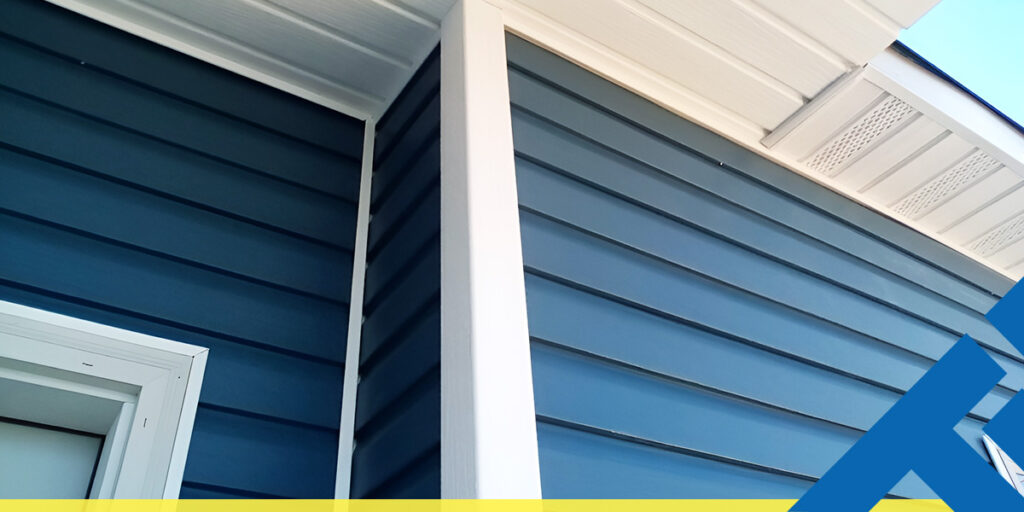
Siding is more than a decorative feature. While it adds charm to your home’s exterior, it fulfills an important function. Siding is the first line of defense against the elements, protecting your house from rain, snow and harsh weather. Over time, this constant battering can take its toll. When faced with worn or faded siding, you have two choices — paint or replace. Painting offers a quick fix, but replacing siding is a durable, long-term solution.
Are you considering replacing your siding over painting it? This guide compares both options to help you make an enlightened decision.
Replacing vs. Painting Your Siding
The difference between these methods lies in the process and suitability for the degree of wear. Paint can provide a cosmetic solution for minor scuffs or fading. For more extensive wear and tear, siding replacement restores your home’s protection. Here’s how each process differs:
Replacing Siding
Siding replacements involve the following steps:
- Removal: The first step is removing the existing siding and any underlying materials.
- Inspection: Next, professionals check for damage or other issues under the old siding. They may also assess the insulation and framing.
- Repair: Before installation, contractors address any problems uncovered during the inspection.
- Installation: After repairs, the team attaches the new siding and seals any gaps. They may apply a weatherproof coating for extra protection against the elements.
Painting Siding
The painting process depends on whether you have vinyl, wood or aluminum siding. These are the basic steps for repainting:
- Inspect: First, examine the siding for mildew, damage or powdery paint residue.
- Repair: If the siding has significant damage, you must repair it before painting. Remember, paint can’t mask severe cracks.
- Cleaning: Start with a clean canvas by washing the siding with a pressure washer and sponge. Make sure you scrape off any loose paint.
- Preparation: Use drop cloths and painter’s tape to avoid accidents.
- Painting: The type of paint depends on the siding material. Speak to a paint supplier about the best choice for your siding to ensure it sticks to the surface.
The Pros of Painting Your Siding
For siding that’s in good condition, a lick of paint can provide a quick and easy update. Painting costs less than replacement. A fresh coat of paint can give your home a new look without the hassle of major renovations. It comes in various hues, so you can get creative with colors and change things up to match your style.
The Cons of Painting Your Siding
While painting can work for a speedy facelift, it fails to address significant wear. Consider these disadvantages:
- Short-term solution: Paint provides a quick cosmetic fix. Maintaining the surface requires frequent repainting to keep it looking fresh. This solution may work for minor fading, but more significant wear requires replacement to avoid costly repairs down the line.
- Unsuitable for all materials: Certain types of siding may not absorb the paint. Vinyl siding, for example, comes in predesigned colors and textures. Paint may fail to bond to the surface. When painting siding, you must ensure the paint works with the material.
- Limited protection: Paint offers little protection from the elements compared to new siding. Chipped or peeling paint exposes your home to environmental threats like moisture or pests.
- May void warranty: Altering the siding can void the manufacturer’s warranty.
- Unpredictable results: The type of paint and siding can impact the finish, leading to mixed results. Achieving consistency with paint is also more challenging.
- Ineffective insulation: Siding insulates your home, increasing energy efficiency. Paint may not address cracks or gaps in the insulation, resulting in higher energy bills.
The Benefits of Replacing Your Siding

Replace your siding if you notice signs of damage, such as fading, rot or missing sections. Other indications include mold or mildew, pests and increased energy costs. In these cases, you’ll need more than a paint job. The good news is that replacing your home’s siding has a host of benefits, including:
Enhanced Protection
Replacing your siding provides a fresh barrier against the elements. It defends your home against moisture, pests and harsh weather. New materials often come with improved resistance to environmental threats.
Improved Energy Efficiency
New siding can enhance insulation, helping regulate indoor temperatures. You enjoy lower energy bills, and your heating and cooling systems can do less work to maintain a comfy interior.
Boosted Curb Appeal
A siding replacement revitalizes your home’s exterior. This upgrade can make it more attractive to passersby or potential buyers. With various styles and colors, you can create a look that reflects your taste and complements the neighborhood. The versatility and variety of vinyl make it a popular siding choice.
Increased Property Value
New siding can increase property value by enhancing aesthetic appeal and structural integrity. It offers a fresh, modern look that attracts potential buyers. High-quality siding materials improve energy efficiency, which is an attractive feature. Many buyers prefer homes with lower maintenance or repair needs.
Reduced Maintenance Needs
Modern siding includes features like fade and peeling resistance, meaning less maintenance. You save time and money on upkeep. The initial expense of replacing the siding is higher, but maintenance and repair savings offset the cost. Vinyl siding, in particular, requires little maintenance.
Better Durability and Longevity
Replacing your siding increases the lifespan and performance of your home’s exterior. Today’s siding can withstand various weather conditions, providing lasting protection. For example, vinyl siding has a life expectancy of around 60 years when properly maintained.
DIY vs. Professional Siding Replacement
For budget-conscious homeowners, DIY siding replacement can seem like a good way to save a few bucks. Before reaching for the power tools, remember that siding installation is complex. Sure, you can save on labor costs and work on your own schedule, but a lack of experience can lead to subpar results. DIY projects can also be time-consuming. Warranties often require professional installation, which can lead to costly issues later. Finally, installing siding yourself carries safety risks without proper training and equipment.
Professional contractors have the skills and knowledge to ensure proper installation. With the right team and tools, they can finish the job quicker with better results. Familiarity with local building codes ensures your siding meets regulations. You enjoy greater peace of mind. Many reputable installers provide warranties on labor and materials, covering any defects. The quality assurance for professional installation far outweighs the costs.
Revitalize Your Home’s Exterior With Total Home Construction
When replacing your home’s siding, select a high-quality product that combines durability and style. Total Home Construction is a trusted supplier of vinyl siding from leading brands. Choose from a wide range of colors, textures and styles to complement your Long Island home. Our proprietary Trim Lock Capping System boosts longevity for added curb appeal.
Trust the experts to recommend good-looking siding that can withstand New England weather! Contact us today for a free house siding inspection.











